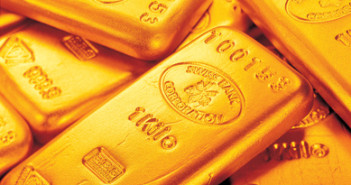Here’s an idea: the European Central Bank could fight deflation by printing euros to buy gold from outside the euro-zone, thus weakening the exchange rate of euro. In turn, exports will become more attractive and import prices will rise, boosting growth and inflation.
Sounds like a crazy idea? It certainly is in the realm of unconventional monetary policy which the ECB has unanimously agreed upon. The central bank has limited tools and may be forced to take action sooner than later. Talking the euro down is now akin to crying wolf. Here is why action is becoming urgent, why the known tools are problematic and 3 advantages of buying gold.
Deflation is taking hold
The specter of Japan’s lost decades is looming over the euro-zone: falling prices can result in consumers deferring buying, less production, less jobs, less consumption, etc. Upon entering such a vicious cycle, it is hard to escape.
Recent euro-zone inflation data for March shows headline CPI at 0.5%, very far from the ECB’s “2% or below” target and the lowest since 2009. Also core inflation, which is the focus of other central banks, is at the post crisis low of 0.7%.
On a constant tax basis (Ben Lord explains here why this is important), deflation is already reality in Italy, Spain and the Netherlands. France is at 0.2% and German inflation is also below 1%. It is not only a case for the “program countries” as Draghi said, or the peripheral ones, but low inflation is seen everywhere. The ECB is not successful in its mission.
A higher level of inflation and support to growth can be achieved by a lower exchange rate of the euro, which remains stubbornly high. EUR/USD is on high ground, the weakness of the yen is keeping EUR/JPY at high ground and the recent halt in the depreciation of the Chinese yuan means that EUR/CNY is also too high. These are the world’s three largest economies.
The ECB has refrained from action in recent months and preferred to keep its powder dry. Instead, officials tried their way by talking about possible tools, the unanimous readiness to use unconventional tools and ever growing explicit mentions of the exchange rate.
Problematic tool #1: negative deposit rate
The possible tools are powerful: Quantitative Easing and a negative deposit rate. Both can do the job, but the ECB seems reluctant to use them.
A negative deposit rate punishes banks for parking money with the ECB and is supposed to make them lend more money to the real economy. It also devalues the euro. However, this uncharted territory, which the ECB is “technically ready” to use, probably scares them off as it could have unintended consequences, such as sending money away also from European bonds.
Draghi’s “everything it takes” speech and the subsequent OMT program from mid 2012 managed to restore confidence in government bonds of these countries much more than any austerity program. It is important to note that debt to GDP ratios continued rising in the euro-zone. Trust made the difference and bridged the gap over reality.
Problematic tool #2: QE
The US, the UK and Japan have launched large scale QE programs in which the central banks buy local government bonds, thus lowering the long term interest rates and also contribute to a lower exchange rate. The ECB is a different story.
How will the ECB decide which bonds to buy? There are 18 member states and any distribution would be criticized. In addition, there is a legal limit on monetary financing and also a moral hazard in doing so. Making such a move would be complicated and would draw not only criticism and legal challenges from Germany, and possibly other countries.
Another option by Jeff Frankel, is that the ECB buys US treasury bonds. This would bypass all the internal issues in Europe and surely lower the exchange rate in much faster way.
Well, this would cause international criticism as it would be a direct intervention in foreign exchange markets by a very big player. Switzerland can maintain a 1.20 floor under EUR/CHF and the world accepts this with acquiescence. It is a small country with an important banking sector (for important people). US/UK/Japanese style QE is not considered direct intervention but domestic policy under the current G20 consensus.
Direct currency manipulation by a huge and democratic economic region would probably not go down quite well and could trigger retaliation.
The solution: gold?
The ECB could buy gold from outside the euro-zone using an expanded balance sheet, or printing euros if you wish.
Here are 3 advantages:
- No legal challenges / moral hazard: as with buying foreign bonds, avoiding the buying of local euro-zone bonds means avoiding any potential violation of the EU treaties, moral hazard and internal criticism.
- No direct FX intervention: Buying the ancient previous metal would not be considered an intervention, even if the intention to lower the value of the euro would be clear. So, by buying gold the ECB would also avoid the external criticism.
- German applause: the ECB is based in Frankfurt and built on the model and way of thought of the German Bundesbank. German wariness of inflation dates back to the Weimar Republic of the ’20s. However, enlarging the physical assets of gold would be welcomed and counter the fears that a lower exchange rate would raise the chances of the dreaded inflation. Germany recently announced it would repatriate some of the gold stored in the United States in a popular move.
Needless to say, announcing the move would send gold prices higher, making it a less attractive investment for the central bank. However, the mere announcement would also lower the value of the euro, having an immediate effect before taking real action. And this is Draghi’s favorite tool: using words instead of action.
What do you think? Is this realistic? What will the ECB eventually do?
Here is more about EUR/USD and more about gold.
